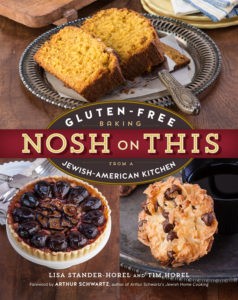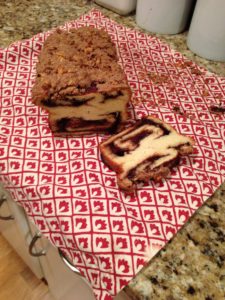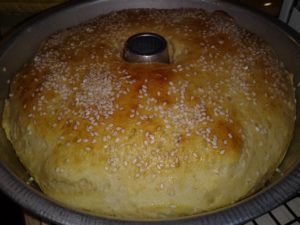 Food is an essential ingredient in Jewish life. So says my partner, Liddy, and I’m sure most agree with her.
Food is an essential ingredient in Jewish life. So says my partner, Liddy, and I’m sure most agree with her.
Last April, when my naturopathic nutritionist recommended I eliminate gluten, corn, soy, dairy, eggs and a number of other foods to see if we could figure out what was causing my joint pain and digestive issues I hoped it was temporary. Six months later, having learned that dairy and eggs don’t cause joint inflammation or digestive issues for me, but gluten, soy, and corn do, and possibly always will, I’m making long-term adjustments.
When I saw recipes for gluten-free honey cake, babka, rugelach, challah, and matzah I jumped at the chance to review Nosh on This: Gluten-Free Baking from a Jewish-American Kitchen, by Lisa Stander-Horel and Tim Horel. Stander-Horel’s introduction is inviting. Her details about gluten-free flours seem thorough. I love that when she describes converting a kitchen to gluten-free and being attentive to cross-contamination she writes, “think of it as you would for kosher preparation, like for Passover.” The layout and the pictures are truly beautiful and in the back is a Jewish foods and Jewish holidays chart.
Yet, when I settled in with the book, I felt overwhelmed.
The recipes seemed complicated beyond my skill or patience. I was instructed to procure several different kinds of flours and measure and mix them. I was supposed to acquire things like Expandex Modified Tapioca Starch, a modified tapioca starch made from the tapioca root that emulates some of the properties of wheat-based ingredients.
I did what any reasonable and overwhelmed person would do in such a situation: I asked for help on Facebook.
In response to my plea, two people less easily daunted than I, Amy, a professional baker in Brookline, MA, and Lisa, a wonderful woman in Maine who knows her way around a cookie, volunteered to test out a few of the recipes.
Here are excerpts from the notes they shared with me:
From Amy:
I do not understand why they didn’t have us proof the yeast before adding it to the other ingredients. I could still see specks of yeast when I was rolling out the dough (at least, that’s what I think it was), and the dough seemed a little gritty.
The instructions seemed overly complicated regarding rolling out the dough multiple times, folding it into an envelope over and over again, and rerolling it. Also, the instructions about coiling it seemed confusing. In the end, my dough was too soft to coil, and it broke just getting it into the pan. I just folded the rope under itself and that seemed just fine.
I more than doubled the cinnamon in the streusel, because I love cinnamon, and added walnuts – to me it’s not a streusel without walnuts.
I don’t know why the recipe would call for extra large eggs. Large eggs are standard in baking, and it was a bit annoying to have to buy a whole new carton of eggs.
The directions to freeze the chocolate chips and grind them in my blender almost broke my blender, and I have a very high-powered blender! In the end, I dumped them out and nuked the chocolate with the butter and spread it on. All was good.
I think for something gluten-free, it came out ok, if a little dry. It probably would have been less dry had I used the oil instead of using all butter. Otherwise, it came together pretty easily.”
From Lisa:
“I made the Quick Round Challah with Poolish. I wish I’d researched more carefully when the recipes first arrived — Expandex isn’t available except by mail-order so I [did] without. The mixed dough looks like cake batter. I don’t have a stand-up mixer with a dough hook. The hand mixer works well, and after about six minutes of steady mixing the dough is more like muffin batter and has a nice sheen.
Takes a good two hours to rise. I pay careful attention to the “don’t over-bake” warning, and set the timer. [I]t smells good, and had a nice flavor. The texture is a bit more biscuit than challah, but not bad.
I also made the Braided Challah. Mixes up pretty easily. Dough is very wet, and even after resting a few minutes, kneading doesn’t make sense without the addition of the extra 1/3 cup of flour. I also added extra beyond that to flour the board and my hands. Braiding it was easier than advertised, and the braid held its shape through the baking.
Took it to the synagogue the next day for a group taste-test. Most thought the flavor was good and similar to wheat challah, but some grumbled about the texture. “Sandy.” “Grainy.” The only person at the table who is currently gluten-free said “pretty good!” The texture was maybe something between a muffin and a scone. But, to this bread’s credit, it held its shape even when we broke into it.
Raisin-Pecan Rugelach. These rugelach aren’t bad, but they aren’t great. The filling is yummy. It makes twice as much filling as you need, but I was happy to use the extra in an apple crisp. Again, got the “sandy” comment. I wish I liked the flour mix better because it’s relatively simple, but I think it just makes things gritty.”
I’m new to this gluten-free world, and it is awesome that there are so many options out here. It’s clear to me that if I want gluten-free Jewish baked goods, I’m going to have to take a deep breath and dive in and give some a try. Even with the mixed reviews, I think Nosh on This is a good place to start.







